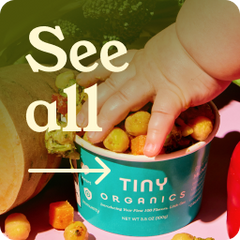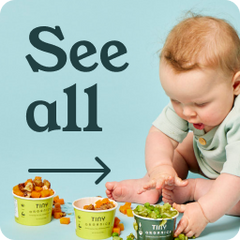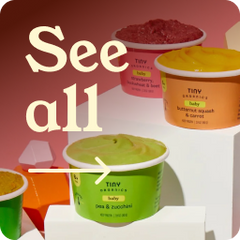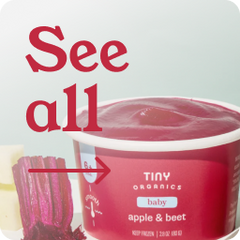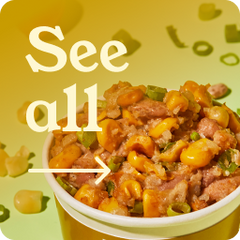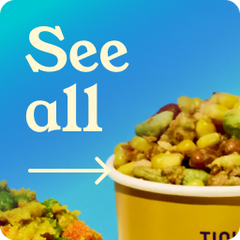The Ultimate Guide to Baby-Led Weaning

Feeding your little ones as they grow can be a challenge - but it’s an exciting one. Letting your baby take the lead on what and when they want to begin eating solid foods is an increasingly popular method of feeding, and it’s one you may want to try. It’s a lot of fun to watch your baby begin to take charge of something in their life!
This guide will tell you everything you need to know about baby-led weaning - what it is, when and how to do it, and everything else you’ll want to pack in your parenting toolbox as you head on this flavor-filled journey.
What is Baby-Led Weaning?
Baby-led weaning is the practice of letting your baby jump right to eating finger foods as soon as you introduce solid foods, as opposed to starting them on the typical mashed-up foods and purées. This method of feeding allows your baby to feed herself the foods she wants, and be in control of how much she chooses to put in her mouth. The parent/caregiver choses what the baby is offered to eat and your child develops the confidence to listen to their own body to determine how much they eat. Fostering a positive relationship with food from the very first bites!
When To Start Baby-Led Weaning
The best time to begin introducing your baby to solid foods is around six months. Most babies at this age can sit up themselves, grab and hold onto objects, and their intestines have developed the enzymes they need to digest solid foods. As this happens, you may have already noticed a change in their poop as it solidifies! Hey, we give it to you with honesty. Instead of spoon-feeding your baby purées at six months, baby-led weaning allows your child to go right to picking up and eating soft foods themselves, at their own pace.
How to Start Baby-Led Weaning
The first step in beginning baby-led weaning is checking with your child’s pediatrician. While it is a completely safe method, it’s not right for every baby, so check in with a professional for a go-ahead if you’re unsure if it’s right for your child.
You should also continue to bottle-feed or breastfeed your baby at the same frequency since milk or formula is where babies get most of their nutrients until they’re one year old. Offering your baby solid foods at each mealtime is good, but you don’t need to ensure he always eats a complete meal - just let him decide what he’s up for eating each time.
Starting baby-led weaning should be a family activity - now you can let your little one eat alongside you. Mealtimes should be a social activity, and your baby will be able to watch what you do with your food and mimic you. Introducing your baby to a wide variety of foods this way can also help develop an adventurous palate.
Best Baby-Led Weaning Foods
Look to offer your baby a wide variety of tastes and textures, opening their eyes and palate to the wonderful world of food through their first bites. The best baby-led weaning foods are ones that are soft, cut into appropriately sized pieces, and are not a choking risk. That gives you a pretty wide variety of solid foods to introduce to your baby.
Some of our favorite first foods are steamed vegetables: carrots, zucchini, sweet potato, yam, parsnips, turnips, spinach, kale, swiss chard, green beans, squash, broccoli, cauliflower, peas, asparagus, beets.
Aim to provide well-rounded options at each meal to introduce other nutrients as well. Ensuring you provide at least one iron-rich food per meal time helps your baby get plenty of this vital nutrient.
Look to avoid adding sugar, salt, or artificial sweeteners to your baby’s food - they don’t add nutritional value, and may set up unhealthy flavor preferences as baby grows. If you want to add some flavor simply toss in your favorite spices into your baby’s meal. Our executive chef loves topping our meals with all your pantry favorites - cinnamon, coriander, nutmeg, paprika, cumin, turmeric. The world is your oyster!
Best Baby Foods by Age
For the beginning of your baby-led weaning journey, offer finger foods that are soft enough for baby to gum easily but firm enough to be cut into grabbable long, thick strips. Foods like yogurt or oatmeal that can’t be cut can be served in clumps that your baby can scoop with their hands, or on a preloaded spoon.
Around nine months, babies begin to develop the motor skills needed to pick up smaller pieces of food with a pincer grasp. At that point you can begin to introduce foods with a slightly firmer texture as your baby gains confidence with solid foods. You’re getting closer and closer to baby being able to share your dinner!
Benefits of Baby-Led Weaning
Baby-led weaning has many benefits. It can encourage your little one to become familiar with a wide variety of foods, textures, and flavors, which can help him develop a varied and healthy palate. Offering baby-led weaning meals like the ones from Tiny Organics, which introduce your baby to their first 100 flavors, can help develop healthy eaters for life.
Another benefit of baby-led weaning is building your baby’s confidence as she gets to pick and choose what and how much she eats. This added baby-led control can also lower the risk of childhood obesity, as your baby will naturally be able to stop when he’s full. And baby-led weaning can help your baby develop her hand-eye coordination and fine motor skills as she learns to grasp and pick up her food on her own. It can be a messy process, but if your baby takes to it, it’s well worth the cleanup.
Tips for Success
Looking to try baby-led weaning, but aren’t sure where to start or what to feed your baby? Try Tiny Organics today - our fresh, nutritious meals are perfect for baby-led weaning or simply introducing solids to your baby’s tastes.










